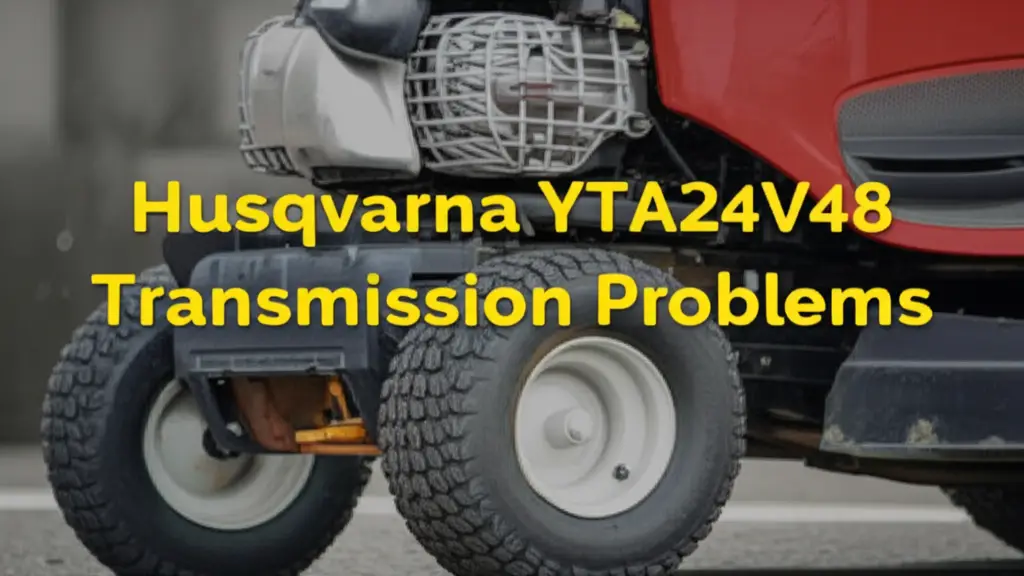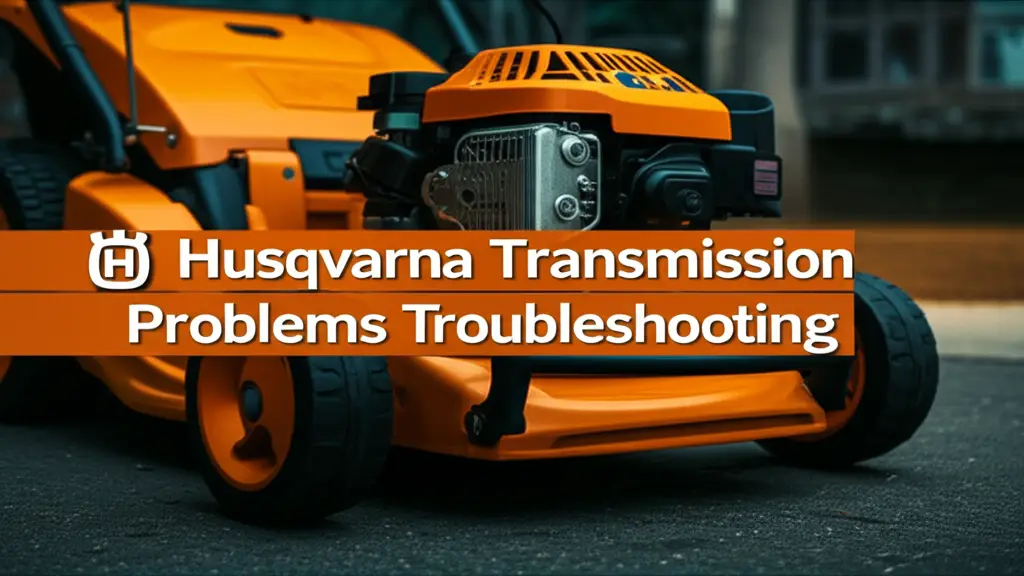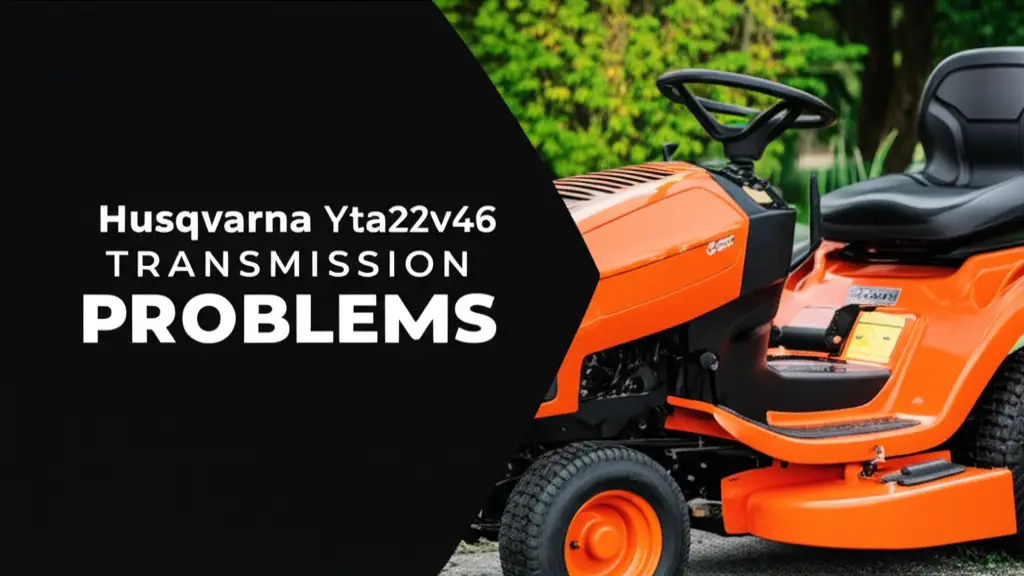· Troubleshooting · 23 min read
Husqvarna Yta24v48 Transmission Problems

Husqvarna YTA24V48 Transmission Problems: Fix Slow Mower
Is a Husqvarna YTA24V48 riding lawn mower struggling to move, losing power on hills, or refusing to go into reverse?
These frustrating transmission problems can turn routine yard work into a significant headache. Understanding the specific nature of the Husqvarna YTA24V48 transmission is the first step toward effective diagnosis and repair.
This comprehensive guide will delve into the common symptoms observed by owners, help diagnose the underlying causes, and provide actionable troubleshooting steps, essential maintenance tips, and insights into potential repair costs.
The aim is to demystify these issues, empowering owners to tackle them with confidence and restore their mower’s performance.
What’s Going On With Your Husqvarna YTA24V48 Transmission?
The Husqvarna YTA24V48 riding lawn mower’s transmission issues typically manifest as a noticeable loss of power, sluggish or no movement in either forward or reverse, or difficulty engaging gears.
These operational challenges frequently trace back to common culprits such as worn drive belts, misaligned control linkages, or internal component wear within its General Transmission Fast CVT system.
Despite being marketed as “sealed for life,” observations indicate that issues like air becoming trapped within the system or leaks from internal seals can occur, necessitating specific troubleshooting and maintenance approaches.
Understanding the YTA24V48’s Transmission: CVT vs. Hydrostatic
The drive system of the Husqvarna YTA24V48 riding lawn mower is centered around its transmission.
A clear understanding of this component is essential for accurate troubleshooting and effective maintenance.
While many riding mowers feature hydrostatic transmissions, the YTA24V48 employs a different technology, which significantly influences how problems are approached.
The General Transmission Fast CVT Explained
The Husqvarna YTA24V48 is specifically equipped with a Fast CVT (Continuously Variable Transmission), manufactured by General Transmission.
This particular model typically features either the RS800LR CVT or the Element V RT400 CVT.
This is a crucial detail, as it distinguishes the YTA24V48’s transmission from the more commonly discussed Tuff Torq hydrostatic units.
Unlike traditional geared transmissions that have distinct speeds or hydrostatic systems that use fluid pumps and motors, CVTs operate using a system of belts and variable pulleys.
This design allows for a seamless and continuous range of speeds without the need for manual gear shifting or a clutch.
The system aims to automatically adjust speed based on demand, providing smooth acceleration and power delivery.
General Transmission often promotes these CVT systems as being “sealed and never needs maintenance,” suggesting that they do not require the routine oil changes or fluid checks associated with many hydrostatic transmissions.
Why This Distinction Matters for Troubleshooting
The manufacturer’s claim that the General Transmission CVT is “sealed and never needs maintenance” implies that traditional fluid checks and changes, which are standard procedures for hydrostatic transmissions like those from Tuff Torq, are not part of the YTA24V48’s routine upkeep.
This is a significant difference that can lead to confusion if owners consult general mower repair guides.
However, real-world experiences and detailed troubleshooting information reveal that despite being “sealed,” these units are not entirely immune to issues related to their internal fluid or seals.
For instance, reports indicate occurrences of “grease seal blowout,” where lubricant escapes the supposedly sealed unit.
Furthermore, Husqvarna’s own support resources detail a “purging” procedure for their riding mowers, a process typically used to remove trapped air from hydraulic systems.
This suggests that while routine fluid changes may not be required, the system can still be affected by air intrusion or compromised seal integrity.
Therefore, troubleshooting efforts for the YTA24V48’s transmission will often focus more on external components like drive belts and control linkages, as well as addressing potential internal mechanical wear or the specific issue of seal failures.
The observation that the manufacturer claims the CVT is “sealed and never needs maintenance,” yet users report “grease seal blowout” and the need for a purging procedure, points to a notable discrepancy.
This suggests that the term “sealed for life” primarily refers to the absence of routine fluid changes or user-accessible fill ports, rather than implying complete immunity from fluid-related issues or the need for internal maintenance.
The presence of seal failures and the requirement for purging indicates that the system, despite its design, is still susceptible to lubricant loss and air ingress.
This understanding is crucial for owners, as it prevents them from overlooking critical maintenance needs based on a potentially misleading claim.
Common Husqvarna YTA24V48 Transmission Problems, Causes, and Solutions
Recognizing the early indicators of transmission trouble can prevent more extensive and costly repairs. Owners of the Husqvarna YTA24V48 frequently report a range of symptoms that signal issues with their mower’s drive system.
Problem: Slow or No Movement (Forward and Reverse)
Description:
One of the most common and frustrating symptoms is the mower moving very slowly, or not at all, even when the accelerator pedal is fully depressed.
This issue can affect both forward and reverse gears, making basic mowing tasks nearly impossible.
Owners often describe the mower as feeling “weak” or lacking sufficient “oomph,” meaning it might move, but without the expected power or speed. The mower might also exhibit “clicking” noises.
Causes:
- Loose, Worn, or Slipping Drive Belt: A very common cause, especially under load. Over time, belts can become worn, frayed, cracked, or stretched, losing their ability to effectively grip the pulleys, leading to inefficient power transfer.
- Incorrect Belt Routing: The belt isn’t threaded correctly through all pulleys and tensioners.
- Worn or Damaged Pulleys/Idlers: These components can become worn, damaged, or misaligned, causing the belt to slip, jump off, or not engage properly.
- Debris Accumulation: Accumulated grass clippings, sticks, or other foreign objects can become jammed in the pulleys or around the belt, preventing free movement or proper tensioner operation.
- Sticking Brake Pedal or Misaligned Linkage: A sticking brake pedal or a misadjusted or disconnected pedal rod leading to the transaxle can prevent the transmission from engaging properly.
- Air in the System (Cavitation): Despite being sealed, air can become trapped within the hydraulic components of the CVT, significantly reducing power delivery and causing sluggishness.
- Internal CVT Issues: Worn internal components like variable pulleys or the shift cam can lead to a complete loss of traction or difficulty maintaining speed.
- Faulty Safety Switches or Electrical Connections: A faulty seat switch, PTO switch, or brake switch, or loose/corroded wiring, can mistakenly prevent the mower from moving.
Solutions:
- Inspect and Adjust the Drive Belt:
- Visually examine the entire belt for wear, fraying, cracking, stretching, or glazing.
- Check for foreign objects or debris.
- Test tension: it should have slight give but feel firm. Refer to the manual for specifications.
- Inspect all pulleys and idler pulleys for free spinning, wobbling, or damage. Verify correct belt routing.
- If worn or damaged, replace the drive belt. Husqvarna YTA24V48 models typically use specific aramid cord belts.
- Perform the Transmission Purging Procedure: This removes trapped air from the hydraulic system.
- Park on a level surface, engine off, parking brake set.
- Disengage transmission by moving the freewheel control to the freewheeling position.
- Start engine, throttle to slow. With motion control in neutral, slowly disengage the clutch/brake pedal.
- Move motion control to full forward for 5 seconds, then full reverse for 5 seconds. Repeat three times.
- Return to neutral, shut down engine, set parking brake.
- Re-engage transmission by moving freewheel control back to engaged position.
- Start engine, throttle to half speed. With motion control in neutral, slowly disengage the clutch/brake pedal.
- Slowly move motion control forward for approx. five feet, then reverse for approx. five feet. Return to neutral. Repeat three times.
- The transmission should now be purged.
- Address Pedal and Linkage Issues:
- Inspect for physical obstructions around pedals.
- Ensure all pivot points and moving parts of the linkage are clean and well-lubricated to allow for smooth movement and full engagement.
- Check that the brake pedal or its wire is not sticking.
- Check Safety Switches and Electrical Connections: Inspect the seat switch, PTO switch, and brake switch for proper function. Check for loose or corroded wiring connections. A multimeter can be used to check continuity.
- Seek Professional Help: If basic troubleshooting doesn’t resolve the issue, or if internal CVT damage is suspected, consult a certified Husqvarna service center.
Problem: Loss of Power on Hills or Uneven Terrain
Description:
A significant indicator of transmission weakness is the mower’s inability to maintain speed or power when attempting to climb inclines or navigate uneven ground.
The mower might move onto a slight grade and then simply stop, despite the pedal being fully pressed.
This problem is often more noticeable when the transmission is warm.
Causes:
- Loose, Worn, or Slipping Drive Belt: Exacerbated under load, leading to inefficient power transfer.
- Internal CVT Issues: Worn pulleys, thinning internal grease (if seals are compromised), or overheating can reduce power delivery when the system is under stress.
- Air in the System: Trapped air can cause sluggishness and reduced power, especially when the transmission is working harder.
- Weak Disconnect Switch Spring: A weak spring on the disconnect switch pull-lever has been identified as a cause for transmission fading on inclines.
Solutions:
- Inspect and Adjust the Drive Belt: Ensure the belt is in good condition, properly routed, and has adequate tension. Replace if worn.
- Perform the Transmission Purging Procedure: This can help restore power if trapped air is the cause.
- Check for Overheating: Ensure the transmission area is clear of debris to allow for proper cooling.
- Inspect Disconnect Switch Spring: Check the spring on the disconnect switch pull-lever for weakness and replace if necessary.
- Seek Professional Help: If the issue persists after these steps, internal CVT problems may require professional diagnosis and repair.
Problem: The Infamous Reverse Pedal Issue
Description:
Many YTA24V48 owners report persistent difficulty engaging or fully depressing the reverse pedal.
This common complaint is often attributed to a specific design flaw: the reverse pedal physically contacts the plastic deck cover when the mower deck is set at its normal cutting height.
While lowering the deck to its lowest position might temporarily alleviate the issue, this is not a practical solution for actual mowing.
Causes:
- Pedal Hitting Deck Cover (Design Flaw): The primary cause is physical interference between the reverse pedal and the mower’s plastic deck cover.
- Sticking Brake Pedal/Wire: Can prevent proper engagement of the reverse mechanism.
- Misaligned Linkage/Pedal Rod: Issues with the connecting rods can hinder full pedal depression.
- Debris: Accumulation of debris under the pedal can restrict its movement.
Solutions:
- Physical Obstruction Check: Inspect for any obstructions, especially the deck cover. Remove any debris lodged between the floorboard and the pedal.
- Adjustment and Lubrication: Inspect the pedal rod and all associated linkages for proper adjustment. Some pedal rods may have threads for adjustment. Ensure all pivot points are clean and well-lubricated for smooth movement and full engagement.
- Aftermarket Modifications: Some users have resorted to adding a piece to the pedal to provide more leverage and allow for full engagement, as Husqvarna has not offered an official “retro fix” or recall for this engineering flaw.
Problem: Unusual Noises, Vibrations, or Rough Shifting
Description:
While the CVT is designed for smooth, clutch-less operation, certain issues can manifest as noticeable noises or vibrations.
A clicking noise, particularly when attempting to engage movement, can indicate underlying problems.
Vibrations or a general sense of rough operation can also signal issues within the transmission or related drive components.
Furthermore, “hard shifting” or difficulty with the pedal returning to a neutral position can be symptoms.
Causes:
- Worn or Damaged Pulleys: Within the drive belt system or internally in the CVT, damaged pulleys can cause grinding, rubbing, or inefficient operation.
- Damaged Drive Belt: A frayed or damaged belt can cause slapping noises or vibrations.
- Debris Accumulation: Debris can accumulate around external pulleys or internal CVT components, hindering smooth operation and causing binding.
- Broken Shift Cam: An internal component that can lead to hard shifting or improper engagement.
- Misaligned Linkage/Incorrect Neutral Setting: Can cause hard shifting or prevent the pedal from returning to neutral.
- Internal CVT Failure: More severe internal damage can lead to significant noises and vibrations.
Solutions:
- Inspect Drive Belt and Pulleys: Check for wear, damage, or debris on the drive belt and all associated pulleys. Replace damaged components.
- Address Pedal and Linkage Issues: Ensure linkages are clean, lubricated, and properly adjusted to allow for smooth pedal movement and return to neutral.
- Check for Debris: Thoroughly clean any debris from around the primary pulley and pedal mechanisms.
- Seek Professional Help: If noises persist or internal damage is suspected, professional diagnosis is recommended.
Problem: Grease Leaks
Description:
Despite the General Transmission CVT being marketed as “sealed,” owners frequently report issues with the transmission’s output (axle) seals.
A “grease seal blowout right rear” has been specifically noted. User reviews confirm that these seals can fail by “popping out” or not staying in place, with some attributing this to a potential design flaw.
Causes:
- Worn or Blown Output Seals: The primary cause is the failure of the transmission’s output (axle) seals, allowing internal lubricant to escape.
- Internal Seal Design Flaw: Some users suggest a design flaw or differences in seal construction (e.g., ribbed vs. smooth outer rim) contribute to their failure.
Solutions:
- Seal Replacement: If a leak is detected, replacing the faulty seal is a necessary repair. Individual output (axle) seals for the General Transmission RS800 can be purchased for around $10-$20 per pair and are often described as an “inexpensive, and easily done fix.”
- Monitor Lubricant Levels: While not user-serviceable for fluid changes, a significant leak will inevitably impact performance due to insufficient lubrication over time.
- Seek Professional Help: If the leak is extensive or if you are uncomfortable with the repair, consult a professional.
Problem: General Reliability Concerns & Warranty Issues
Description:
Customer reviews for the Husqvarna YTA24V48 are notably mixed, with a significant number reporting substantial issues concerning its overall reliability and durability.
Common complaints frequently highlight problems directly related to the transmission, alongside concerns about the mower deck and general build quality.
Some customers have voiced extreme dissatisfaction, specifically citing recurring transmission issues such as slipping and difficulties with both forward and reverse movement.
There are also reports of difficulties with Husqvarna warranty claims, with issues sometimes being attributed to “user fault.”
Causes:
- Potential Manufacturing Defects: Instances like a transmission being “bone dry” from the factory after only 5 hours of use suggest potential manufacturing defects or lapses in quality control.
- Inherent Design Vulnerabilities: The consistent reporting of certain issues, like the reverse pedal design flaw or recurring seal failures, points to potential inherent design vulnerabilities in the General Transmission CVT units.
- Inconsistent Manufacturing Process: Recurring problems imply inconsistencies in the manufacturing process of the integrated CVT units.
- Warranty Claim Challenges: Customer reports indicate a potential gap between the stated warranty policy and the actual customer experience, with issues sometimes being attributed to “user fault.”
Solutions:
- Diligent Documentation: To navigate potential warranty challenges effectively, diligently document all maintenance performed, keep records of any symptoms observed, and note all troubleshooting steps taken. Detailed records can be crucial for supporting a warranty claim and disputing any claims of “user fault.”
- Leverage Warranty and Dealer Support: The Husqvarna YTA24V48 typically comes with a 24-month warranty covering the transmission. If a product is broken and a warranty claim is desired, it must always be examined by an authorized dealer. For information on finding parts or support, exploring Finding Husqvarna Parts Online or contacting Husqvarna directly can be beneficial.
- Proactive Maintenance: Regular cleaning, visual inspections, and addressing minor issues early can help prevent escalation of problems and support warranty claims.
General Troubleshooting and Maintenance Strategies
Safety First: Preparing for Inspection
Before attempting any inspection or repair on a riding lawn mower, safety must be the top priority. Always ensure the parking brake is firmly applied, the engine is completely turned off, and the ignition key is removed from the switch.
These steps are critical to prevent accidental starting or unexpected movement of the mower, which could lead to serious injury.
Step-by-Step Purging Procedure: Clearing the Air
Despite the General Transmission CVT being described as “sealed,” air can become trapped within the hydraulic components of the system.
This can happen during shipping, after the mower has been stored for a long period, or if the transmission was removed for service or replacement.
This trapped air, a condition known as “cavitation,” can significantly reduce power delivery and cause the mower to feel sluggish or unresponsive.
Performing a purging procedure helps to remove this air and restore proper function.
This procedure is particularly recommended before operating a new tractor for the first time to clear any air introduced during shipping.
If the transmission has been removed for service or replacement, it should be purged again after reinstallation.
Step-by-step Purging Procedure:
- Preparation: Park the mower safely on a level, clear, and open surface. Ensure the engine is off and the parking brake is set.
- Disengage Transmission: Locate the freewheel control (usually at the rear of the mower) and move it to the freewheeling position. This disengages the transmission, allowing the wheels to move freely. (Consult your operator’s manual under the “TO TRANSPORT” section for precise location and operation of the freewheel control).
- Initial Engine Start: While seated in the operator’s seat, start the engine. Once running, move the throttle control to the slow position. With the motion control lever (or pedal) in the neutral position, slowly disengage the clutch/brake pedal.
- Forward/Reverse Cycles (No Load): Move the motion control lever (or pedal) to the full forward position and hold it for five seconds. Then, move the lever to the full reverse position and hold it for five seconds. Repeat this forward and reverse procedure three times. During this step, the drive wheels may exhibit some movement, but they are not under load; this action helps to remove air from the hydraulic drive system.
- Return to Neutral & Shut Down: Move the motion control lever back to the neutral position. Shut off the engine and set the parking brake.
- Engage Transmission: Re-engage the transmission by moving the freewheel control back into the engaged position.
- Second Engine Start: While seated, start the engine again. Once running, move the throttle control to half speed. With the motion control lever in the neutral position, slowly disengage the clutch/brake pedal.
- Forward/Reverse Cycles (Under Load): Slowly move the motion control lever forward. After the tractor moves approximately five feet, slowly move the motion control lever to the reverse position. After the tractor moves approximately five feet in reverse, return the motion control lever to the neutral position. Repeat this procedure with the motion control lever three times.
- Completion: Your transmission should now be purged and ready for normal operation.
Maintaining Your YTA24V48 for Long-Term Performance
Proactive maintenance is key to extending the lifespan of a Husqvarna YTA24V48 and preventing common transmission problems.
Regular Cleaning and Visual Inspections
Keeping the mower clean, particularly the areas around the deck, belts, pulleys, and the transmission, is fundamental.
Accumulated grass clippings and other debris can impede belt movement, cause excessive friction, and lead to overheating, all of which can negatively impact transmission performance.
It is recommended to clean the outer and inner surfaces of the cutting deck regularly, using a water hose when the deck is in the service position.
Beyond cleaning, regular visual inspections are crucial. Periodically check all belts for signs of wear and proper tension, ensure tire pressure is correct, and confirm that all connections and fasteners are secure.
Addressing minor issues like loose bolts or minor debris buildup early can prevent them from escalating into major transmission problems. More comprehensive guidance can be found in(https://www.lawntrend.com/husqvarna-riding-mower-transmission-problems).
Understanding CVT “Sealed for Life” vs. Real-World Maintenance
While the General Transmission CVT in the YTA24V48 is designed to be “sealed and never needs maintenance,” this claim primarily means that routine fluid changes are not part of the recommended service schedule.
However, this does not imply the transmission is impervious to all fluid-related issues.
As observed, seals can still fail, leading to grease leaks. If a seal blows out, lubricant will escape, which can eventually lead to internal component wear if not addressed. Additionally, air can become trapped within the system, necessitating the purging procedure as detailed earlier. Therefore, regular visual checks for any signs of grease leaks around the transaxle are important. If a leak is detected, replacing the faulty seal is a necessary repair, despite the “sealed” design. This understanding helps manage expectations and ensures that critical maintenance, even if not routine fluid changes, is performed.
When to Seek Professional Help
If basic troubleshooting steps—such as inspecting and adjusting the drive belt, checking linkages, and performing the transmission purging procedure—do not resolve the issue, or if internal transmission damage is suspected, it is advisable to consult a certified Husqvarna service center.
Complex internal issues, such as broken CVT pulleys, damaged shift cams, or significant grease seal blowouts, often require specialized tools, diagnostic equipment, and expertise that a typical homeowner may not possess.
Attempting complex internal repairs without the necessary knowledge or tools can lead to further damage and increased repair costs.
Professional technicians can accurately diagnose intricate problems and perform the necessary repairs, ensuring the mower is safely and correctly restored to working order.
Cost of Husqvarna YTA24V48 Transmission Repairs and Parts
The cost of addressing Husqvarna YTA24V48 transmission problems can vary significantly, ranging from inexpensive DIY fixes to substantial expenses for major component replacements or professional service.
Common DIY Fixes: Belts, Seals, and Minor Adjustments
Many common transmission-related issues can be resolved with relatively inexpensive parts and a bit of DIY effort.
- Drive Belts: Replacement drive belts for the YTA24V48 typically range from $20 to $80, depending on whether an OEM (Original Equipment Manufacturer) part or an aftermarket equivalent is chosen. These are generally considered manageable replacements for the average homeowner.
- Output Seals: Individual output (axle) seals for the General Transmission RS800, which is used in the YTA24V48, can be purchased for around $10-$20 per pair. Replacing these seals is often described as an “inexpensive, and easily done fix,” taking about 30 minutes.
- Minor Adjustments: Adjusting belt tension, cleaning debris from around pulleys and linkages, or lubricating sticking pedal mechanisms are typically free, requiring only time and basic tools.
Replacement Transmission Assembly Costs
Replacing the entire transmission assembly is a considerably more expensive undertaking.
- A new General Transmission RS800 transaxle can cost approximately $415 to $500.
- A General Transmission RT400 transaxle, another variant used in the YTA24V48, might range from $480 to $710.
- For context, general hydrostatic transmissions (not specific to the YTA24V48) can range from $139 for used parts to over $1,000 for new OEM units, illustrating the wide range of transmission costs across different mower types. While automotive CVT replacements can be significantly higher ($3,000-$8,000 including labor), mower transmissions are generally less complex and thus less expensive.
Weighing DIY vs. Professional Repair Costs
The decision between a DIY repair and professional service often comes down to the complexity of the issue and the associated costs.
- DIY repairs for common issues like worn belts or leaking seals can result in significant labor cost savings, as the parts themselves are relatively inexpensive. Many owners find these fixes manageable with readily available online guides and basic tools.
- For a full transmission replacement, professional labor can add hundreds to thousands of dollars to the part cost, depending on the shop’s rates and the time required for the repair.
- When faced with a costly transmission replacement, it is prudent to consider the age and overall condition of the mower. If the repair cost approaches or exceeds a significant percentage of the value of a new mower, investing in a new machine might be a more economical long-term solution.
Estimated Costs for Husqvarna YTA24V48 Transmission-Related Parts
| Part Type | Estimated DIY Part Cost (USD) | Notes |
|---|---|---|
| Drive Belt | $20 - $80 | Varies by OEM vs. aftermarket, specific model variant. |
| Output (Axle) Seals | $10 - $20 (per pair) | For General Transmission RS800. |
| General Transmission RS800 Transaxle (New) | $415 - $500 | Complete assembly. |
| General Transmission RT400 Transaxle (New) | $480 - $710 | Complete assembly. |
| Professional Labor | Varies widely ($100s - $1000s) | Additional cost if not DIY. |
Common Customer Feedback on YTA24V48 Reliability
Customer reviews for the Husqvarna YTA24V48 are notably mixed. While some owners express satisfaction with the mower’s power and ease of use, a significant number report substantial issues concerning its overall reliability and durability.
Common complaints frequently highlight problems directly related to the transmission, alongside concerns about the mower deck and general build quality.
Some customers have voiced extreme dissatisfaction, describing the mower as “junk” or the “worst riding mower ever,” specifically citing recurring transmission issues such as slipping and difficulties with both forward and reverse movement.
A particularly concerning report detailed a transmission replacement after merely 5 hours of use because the unit was found to be “bone dry” from the factory.
This indicates a potential manufacturing defect or a lapse in quality control during the assembly or pre-delivery inspection process.
Another owner mentioned having to replace the drive belt multiple times due to persistent transmission slipping, and experiencing a progressive decline in both reverse and forward drive capabilities.
The consistent reporting of transmission issues, including instances of early failure like a “bone dry” unit at just 5 hours, strongly suggests a pattern that goes beyond typical wear and tear.
This points to potential inherent design vulnerabilities or inconsistencies in the manufacturing process of the General Transmission CVT units integrated into the YTA24V48.
Such recurring problems, coupled with user frustrations regarding warranty claims, imply that the support provided for these known issues may not always meet customer expectations.
This situation underscores a systemic reliability concern with this specific model’s transmission.
Frequently Asked Questions (FAQ)
Q1: Why is my Husqvarna YTA24V48 moving so slowly?
A: Slow movement is often caused by a loose, worn, or slipping drive belt, or issues with the pedal linkages. It could also indicate air trapped in the transmission, requiring a purging procedure, or internal wear within the CVT unit.
Q2: Does the Husqvarna YTA24V48 use a hydrostatic transmission?
A: No, the Husqvarna YTA24V48 is equipped with a General Transmission Fast CVT (Continuously Variable Transmission), such as the RS800LR or RT400, not a hydrostatic transmission like a Tuff Torq K46. This means its internal workings and maintenance differ.
Q3: Why is the reverse pedal on my YTA24V48 hard to engage?
A: This is a common design flaw where the reverse pedal hits the plastic deck cover when the deck is at normal cutting height. It’s not typically an internal transmission problem, but rather a physical obstruction. Check for debris or consider a pedal modification.
Q4: Can I change the transmission fluid in my Husqvarna YTA24V48?
A: The General Transmission CVT in the YTA24V48 is marketed as “sealed and never needs maintenance,” implying no routine fluid changes. However, grease seals can fail, leading to leaks. If a leak occurs, the seal needs replacement, but traditional fluid changes are not part of routine maintenance.
Q5: What does “purging the transmission” mean for my YTA24V48?
A: Purging the transmission involves a specific procedure to remove trapped air from the hydraulic system, which can cause sluggishness or loss of power. This is especially important for new mowers or after transmission service, even for sealed CVT units.
Q6: How much does it cost to replace the transmission on a Husqvarna YTA24V48?
A: Replacing the entire General Transmission CVT unit can range from approximately $415 to $710 for the part alone, depending on the specific model (RS800 or RT400). This cost does not include professional labor, which can add significant expense.
Q7: What are the most common DIY fixes for YTA24V48 transmission issues?
A: The most common DIY fixes involve inspecting and replacing worn drive belts (costing $20-$80), replacing leaking output seals ($10-$20 per pair), and performing the transmission purging procedure. Adjusting linkages and cleaning debris are also simple DIY tasks.
Conclusions & Recommendations
The Husqvarna YTA24V48 riding lawn mower, while offering certain performance advantages with its General Transmission Fast CVT, presents owners with a unique set of transmission-related challenges.
The analysis reveals that many issues, from slow movement to power loss on hills, frequently stem from common culprits such as worn drive belts, misaligned linkages, or internal CVT component failures like axle seal blowouts. A significant observation is the contradiction between the “sealed for life” manufacturer claim and the real-world occurrence of seal failures and the necessity of air purging.
This highlights the importance of proactive visual inspections for leaks and understanding the purging procedure as a fundamental diagnostic step.
Furthermore, specific design flaws, such as the reverse pedal hitting the deck cover, contribute to user frustration and can be mistakenly attributed to internal transmission problems.
This underscores the value of systematic troubleshooting, starting with the simplest, most accessible checks before escalating to complex internal diagnostics.
While many common problems are amenable to DIY repairs, potentially saving significant costs, major internal failures or a full transmission replacement can be substantial investments.
Owners are advised to weigh the cost of repair against the mower’s age and overall condition.
By understanding these nuances, owners can make informed decisions, extend their mower’s lifespan, and ensure a more efficient mowing experience.
- Husqvarna transmission
- YTA24V48 problems
- hydrostatic transmission
- lawn mower repair
- transmission troubleshooting




